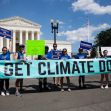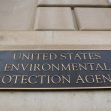Modern concerns over climate change have thrust the environment into the international spotlight, but not for the first time. In the 1960s, industrialism in the United States led to environmental degradation that became difficult to deny. In one alarming example, the Cuyahoga River caught fire. The flames on the surface of what, at that point, could only loosely be described as a body of water served as a striking symbol of environmental destruction. In 1962, seven years before the Cuyahoga served as a fiery warning, Rachel Carson published a highly influential book titled "Silent Spring." Carson drew attention to the damage caused by DDT (dichlorodiphenyltrichloroethane) to bird populations, including the symbol of American freedom and bravery: the bald eagle.
DDT causes the thinning of the eggshells for these majestic birds and many other species, triggering rapid declines in their populations. The title warned that with the native birds dying off, springtime would be marked with an eerie silence as the natural world became barren. Certainly, rivers such as the Cuyahoga already had lost all signs of life because of the damage caused by industrial dumping. The photos of the pollution can only show so much; descriptions suggest that the smell might have been the most revolting indication of the harm caused by human industrial practices.
In 1970, President Nixon took heed of these alarm bells and moved to clean up America's water and air. The Nixon Administration took several bold steps to prevent industrialization from annihilating the environment and poisoning humans. The nation's main environmental laws date back to that period when Congress enacted the Clean Water Act, the Clean Air Act, the National Environmental Policy Act, and the Endangered Species Act. At this time, Congress also delegated power to the newly formed Environmental Protection Agency. The decades since Nixon enacted these laws have led to a politicization of the EPA and environmental issues in general. Republicans, starting with the Reagan Administration, began pushing back against the EPA.
Under the Trump Administration, the EPA took slashes to its funding. The current administration argues that the EPA needed to step back and let states regulate their environments. Republicans often cite states’ rights as a way to cut funding and power from federal agencies. But how does the power divide between states and the federal government work when it comes to regulating the environment?
The Feds and the States Both Play a Part
The EPA gets its power from Congress. The Constitution of the United States does not mention the environment. Like many other aspects of the modern world, the Framers could not predict humans' impact on our natural surroundings. However, the Constitution does grant Congress powers to "regulate commerce with foreign Nations, and among the several States, and with the Indian Tribes." It is upon this language that all of our environmental laws depend. The EPA gets its power from Congress, and Congress remains above the EPA in terms of that power. Like all federal agencies, the EPA can therefore enact rules as long as they are within their granted authority.
The EPA can and does set standards regarding environmental regulations, but in general, the EPA's standards are the minimum that all states must meet. The states can create additional regulations that go a step further to protect the environment. However, in terms of the Clean Air Act, states are somewhat limited in the standards they can set. California has the power to increase the standards, and states can opt into those set by California or comply with only the less stringent EPA rules.
In practice, the states rely a great deal on the EPA to regulate the environment and corporations. Many individuals concerned about the environment are dismayed by the recent cuts to the EPA's budget.
The Feds Step Back Under Trump
During the Trump Administration, the EPA has been conducting far fewer inspections than it did under the Obama Administration. The number of inspections conducted in 2019 was about half of the average performed during each of the eight years under Obama.
Environmentalists were horrified when the President selected Scott Pruitt to lead the EPA, especially because Pruitt does not believe that climate change is real. The Administration moved to weaken many environmental laws and regulations. Changes to the Clean Water Act included reducing protections for anywhere from 60 to 90 percent of the nation's waterways. The lack of federal protections from so many waterways could mean risks to endangered species and ecosystems, as well as for drinking water. According to some environmentalists, the new approach could even bring back the river fires of the mid-twentieth century.
In recent years, other efforts include loosening regulations on companies that emit toxic pollutants into the air and setting aside a rule that required mining companies to retain a fund to cover the costs of cleaning the pollution that they cause.
The States Cannot Regulate Without the EPA
There are compelling reasons why states cannot effectively enforce environmental regulations. First, state officials are motivated to protect their own state and not other states. However, environmental damage is not contained within borders. Pollution can flow downstream into another state that may have no power to regulate the out-of-state polluter. Furthermore, many of the companies that damage the environment operate in various parts of the country. The EPA has the power to make these businesses follow environmental standards across the board rather than in an inefficient piecemeal process state by state.
State officials are also tied to the interests of local industries. If the state politics are intertwined with an industry like coal - as is the case in West Virginia - the chances of that state effectively regulating that industry are slim. Federal regulation is less subject to local special interests, making the EPA a better policing agency.
Without the EPA available to back up states, powerful companies may take bolder stances in opposition to state regulations as they will no longer fear a federal backlash. Companies that are willing to violate the rules will save costs while those who comply will become less competitive. States that allow polluters to destroy the environment will become popular with industrial leaders looking to cut corners. In essence, without federal oversight, states will lose much of their power to enforce environmental protections, and America could see an environmental race to the bottom.
What Happens Next
The environmental policies of the Trump Administration and those proposed by Vice President Biden differ substantially. Four more years under Trump will likely see the EPA further eroded. If Biden wins in November, the EPA could gain back some of its authority.
Interestingly, generational views on the environment show that a majority of younger voters, both those who identify as liberal and those who identify as conservative, support better protection of the environment. Some environmental policies, such as efforts to develop green and renewable energy, could become bipartisan under the right leadership. Hopefully, politicians can reach some agreements about environmental protections before we are forced to witness a resurgence of flaming rivers.






